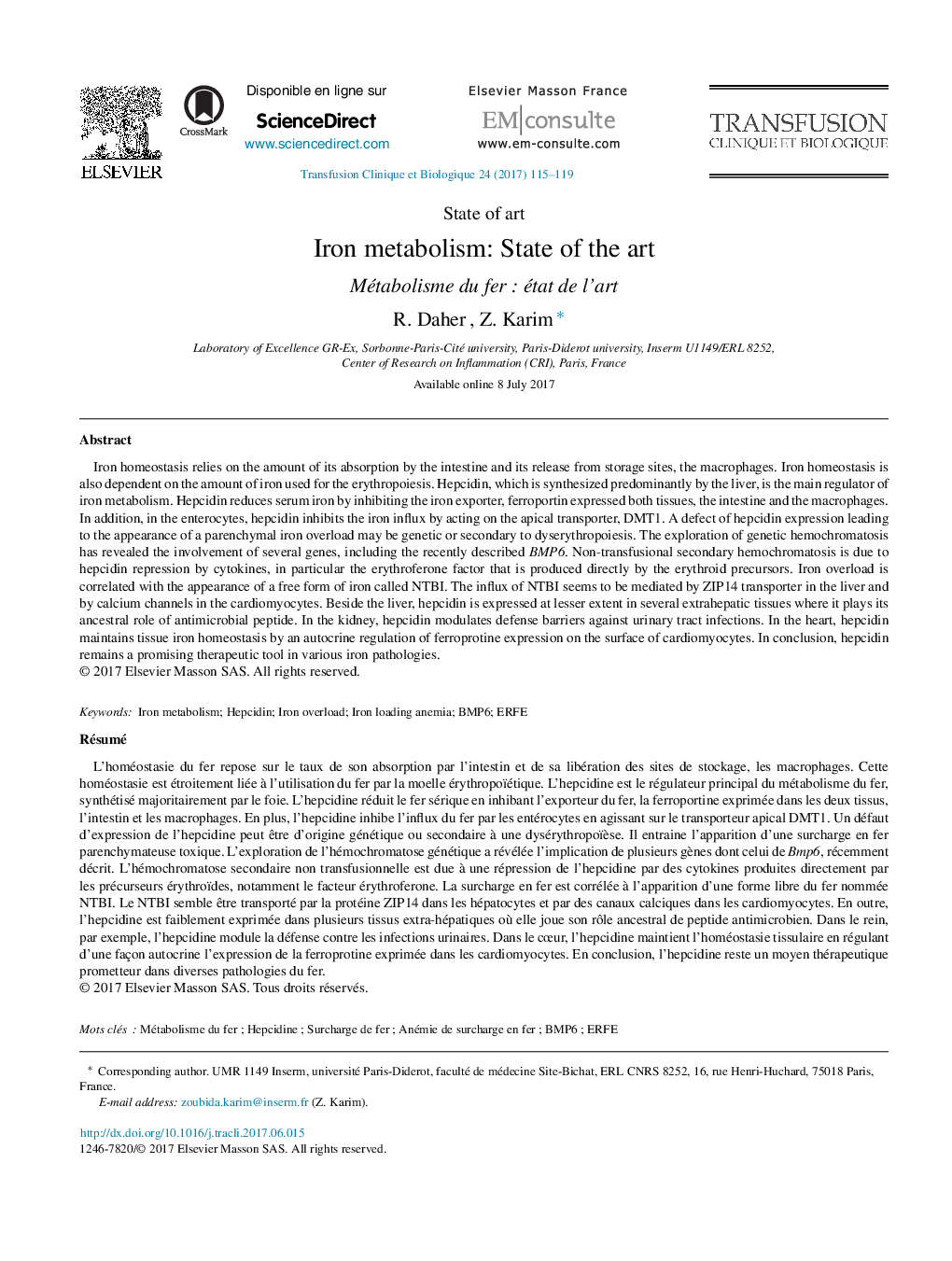| کد مقاله | کد نشریه | سال انتشار | مقاله انگلیسی | نسخه تمام متن |
|---|---|---|---|---|
| 5124717 | 1488254 | 2017 | 5 صفحه PDF | دانلود رایگان |
Iron homeostasis relies on the amount of its absorption by the intestine and its release from storage sites, the macrophages. Iron homeostasis is also dependent on the amount of iron used for the erythropoiesis. Hepcidin, which is synthesized predominantly by the liver, is the main regulator of iron metabolism. Hepcidin reduces serum iron by inhibiting the iron exporter, ferroportin expressed both tissues, the intestine and the macrophages. In addition, in the enterocytes, hepcidin inhibits the iron influx by acting on the apical transporter, DMT1. A defect of hepcidin expression leading to the appearance of a parenchymal iron overload may be genetic or secondary to dyserythropoiesis. The exploration of genetic hemochromatosis has revealed the involvement of several genes, including the recently described BMP6. Non-transfusional secondary hemochromatosis is due to hepcidin repression by cytokines, in particular the erythroferone factor that is produced directly by the erythroid precursors. Iron overload is correlated with the appearance of a free form of iron called NTBI. The influx of NTBI seems to be mediated by ZIP14 transporter in the liver and by calcium channels in the cardiomyocytes. Beside the liver, hepcidin is expressed at lesser extent in several extrahepatic tissues where it plays its ancestral role of antimicrobial peptide. In the kidney, hepcidin modulates defense barriers against urinary tract infections. In the heart, hepcidin maintains tissue iron homeostasis by an autocrine regulation of ferroprotine expression on the surface of cardiomyocytes. In conclusion, hepcidin remains a promising therapeutic tool in various iron pathologies.
RésuméL'homéostasie du fer repose sur le taux de son absorption par l'intestin et de sa libération des sites de stockage, les macrophages. Cette homéostasie est étroitement liée à l'utilisation du fer par la moelle érythropoïétique. L'hepcidine est le régulateur principal du métabolisme du fer, synthétisé majoritairement par le foie. L'hepcidine réduit le fer sérique en inhibant l'exporteur du fer, la ferroportine exprimée dans les deux tissus, l'intestin et les macrophages. En plus, l'hepcidine inhibe l'influx du fer par les entérocytes en agissant sur le transporteur apical DMT1. Un défaut d'expression de l'hepcidine peut être d'origine génétique ou secondaire à une dysérythropoïèse. Il entraine l'apparition d'une surcharge en fer parenchymateuse toxique. L'exploration de l'hémochromatose génétique a révélée l'implication de plusieurs gènes dont celui de Bmp6, récemment décrit. L'hémochromatose secondaire non transfusionnelle est due à une répression de l'hepcidine par des cytokines produites directement par les précurseurs érythroïdes, notamment le facteur érythroferone. La surcharge en fer est corrélée à l'apparition d'une forme libre du fer nommée NTBI. Le NTBI semble être transporté par la protéine ZIP14 dans les hépatocytes et par des canaux calciques dans les cardiomyocytes. En outre, l'hepcidine est faiblement exprimée dans plusieurs tissus extra-hépatiques où elle joue son rôle ancestral de peptide antimicrobien. Dans le rein, par exemple, l'hepcidine module la défense contre les infections urinaires. Dans le cÅur, l'hepcidine maintient l'homéostasie tissulaire en régulant d'une façon autocrine l'expression de la ferroprotine exprimée dans les cardiomyocytes. En conclusion, l'hepcidine reste un moyen thérapeutique prometteur dans diverses pathologies du fer.
Journal: Transfusion Clinique et Biologique - Volume 24, Issue 3, September 2017, Pages 115-119
